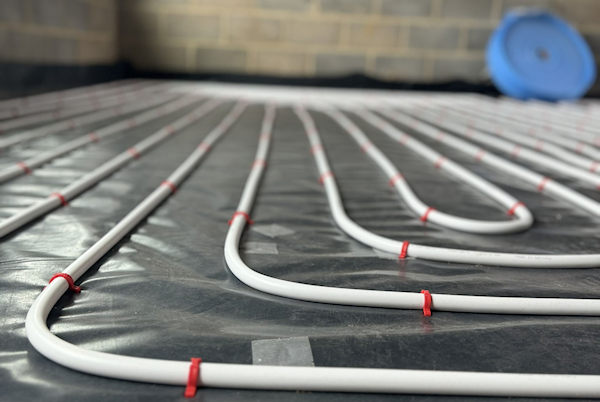
Changes to Building Regs Part L, F & O
In December 2021, the UK Government announced the first major changes to the Building Regulations in nearly a decade by releasing the latest approved documents affecting parts L, F & O. The Future Homes Standard (FHS) is due to be implemented in 2025. The new building regulations form part of the Government policy to achieve the FHS.
The FHS dictates that new homes need to produce at least a 75% reduction of CO2 emissions. Therefore, the recently released Part L version aims for an average decrease of 27% to 30% in CO2 emissions. The decrease provides a springboard to the upcoming requirements of the Future Homes Standard. As a result, all new heating systems will have to be designed with a maximum flow temperature of 55°C or lower from June this year.
The regulations provide flexibility on meeting the targets, and there are a variety of renewable energy sources already on the market, providing installers with options to suit different types of buildings. However, the Government expects heat pumps to become the primary heating technology for new homes. In addition, there is also a requirement for automated and zoned control devices.
Underfloor Heating paves the way
By their very nature, water-based underfloor heating systems can easily comply with the new, upcoming requirements and present other benefits for the installer and the homeowner.
Underfloor heating systems cover a greater surface area than radiators. Therefore, such systems should run 24 hours a day at a lower temperature (35-55°C rather than 80°C for gas boilers) for maximum efficiency. When a heat pump runs at 35°C, UFH can perfectly accommodate the optimal coefficient of performance (COP) for heat pumps. UFH can also be fully zoned, ticking a crucial regulatory box and ensuring the end-user wastes less energy.
Hidden value for homeowners
Much has been reported on the cost of heat pumps and UFH compared to traditional boiler/radiator systems. Still, as long as a heat pump is suitable for your project, there may be some further benefits to the investment. In addition to compliance with the upcoming changes, and thermal comfort, installers can also advise end-users that they are likely to benefit from reduced operational costs.
Compared to traditional radiator systems, a UFH system should be cheaper to run between 15% and 40%. In addition, UFH systems require very little maintenance and will likely outlive the building itself. End-users can be offered further reassurance as standard radiators are often replaced every 10 to 20 years, whereas Multipipe offer a 50- year warranty on our MLCP pipework.
UFH also offers a number of safety, health, and aesthetic benefits and future-proofing new properties per the new Part L regulations.
The absence of radiators maximises the available wall space and provides the kind of clean lines modern homeowners favour. In addition, it makes every area in the home a little safer, while air quality within the property is also improved by significantly reducing household particle movement.
Ongoing challenges for our industry
Our industry faces many real challenges to ensure we can all meet the requirements of the FHS. For example, upskilling tradespeople to ensure our industry has the number of highly trained individuals needed to install lower carbon heating solutions to their customers.
The Government needs to provide further clarification on some elements of the regulations. For example, suppose a wet heating system has been newly installed or fully replaced in an existing building. In that case, it should be sized with a maximum flow temperature of 55°C or lower whilst allowing the system to meet the heating needs of the building. This needs to push harder the requirements of insulating the property to ensure less leakage, which some house can then run risk of condensation is sealed too much.
If this is not possible, the system must be designed to the lowest design temperature feasible whilst still meeting the heating needs of the residence. Therefore, a ‘Good Practise’ specification appendix has been added for a new home designed to be heated by a heat pump.
Uplifts to Part L and F have new minimum efficiency standards for existing homes. These include a new way of calculating whole house heat losses for new extensions. A transition period now starts, which will end in June 2022, when these new regulations will come into effect.
What to do now
There are still five months before the regulations apply, so we recommend familiarising yourself with the requirements of the updated rules. It’s also worth thinking about your planned new build work to ensure you know which parts of Part L will apply to your projects.
For projects with plans or notices submitted before June, there’s a cut-off date of June 2023 for the building to start for the current Part L (2013) to apply. From that point on, older versions of Part L will no longer apply to any projects, regardless of when the plans or notices were submitted.
Any plans or notices submitted after June next year must adhere to the new interim Part L standards.
It is also worth bearing in mind that this is a very short interim period, with 2025 ushering in the next Part L update. Although the proposed technical specification will not likely be available until 2023, the Government has indicated the U-values it will expect.
Accuracy is vitally important in designing and installing a heat pump system to ensure efficiency and avoid inflated energy bills compared to a traditional gas boiler system. You must calculate heat losses to ensure the end-user has a system that meets their temperature requirements. When requesting a bespoke Multipipe UFH system, we will help ensure the system is fit for purpose by helping with these calculations.
It is an extremely busy time as the industry absorbs building regulations’ changes and their impact on working practices. To help installers adapt as quickly as possible, we’re here to help with training and technical advice for all Multipipe systems.











